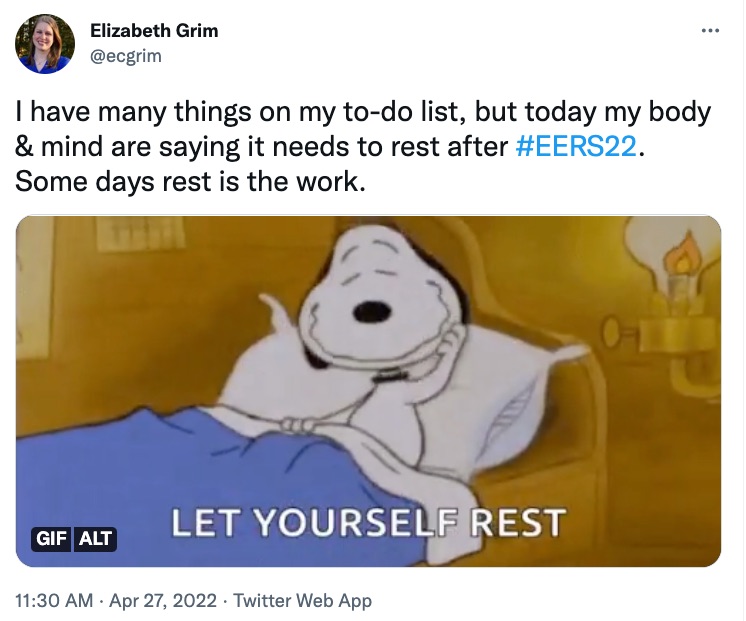Hello, AEA365 community! Liz DiLuzio here, Lead Curator of the blog. This week is Individuals Week, which means we take a break from our themed weeks and spotlight the Hot Tips, Cool Tricks, Rad Resources and Lessons Learned from any evaluator interested in sharing. Would you like to contribute to future individuals weeks? Email me at AEA365@eval.org with an idea or a draft and we will make it happen.
Hi, my name is Elizabeth Grim! I am the Founder & Principal Consultant of Elizabeth Grim Consulting, LLC; Curator of AEA365; and Past President of the Eastern Evaluation Research Society (EERS), an AEA Affiliate.
Something that I am continuously exploring in my work is how to make content more accessible, including incorporating alternative text (or alt text) for images. As with everything related to evaluation, writing good alt text is a learning journey, and we get better the more we know and practice.
What is alt text?
Alt text is a written description of images (e.g., pictures, charts, graphs, GIFs, etc.), that provides context and sense-making of an image when it is unable to be accessed visually. For example, screen readers interpret alt text for those who are blind or have a visual impairment, while websites display alt text in place of an image when a browser is not loading the content.
You may have seen alt text listed in HTML on a website as: alt=”description of the image here”. Or perhaps you have seen a text description pop up as you hover over an image.
Here’s a recent example of alt text describing a GIF I posted on Twitter:

Hot Tips
- Add alt text to meaningful images. Provide alt text for all images that add meaning to the document. You can mark content such as page borders or line breaks as decorative so that the screen reader understands which images are important and need to be interpreted.
- Consider the context. Think about the context in which the image is being shared. What information or feeling is the visual trying to convey? What information might someone miss if they cannot view the image?
- Be clear, concise, and accurate. Write the description in a simple, clear, and brief sentence. For example, provide the takeaway message instead of providing every level of detail for a chart. If you want to know how the description will sound, try a test using a screen reader.
- Include any words or phrases in the image. If your visual includes text or words, be sure to include those in the alt text.
- Avoid redundancy. When starting out with alt text, you may find yourself beginning the description with the words “image of” or “picture of” (I sure did!). Screen readers are advanced enough to understand what is an image, so you can begin the alt text immediately with the description.
- Look for inspiration: I find inspiration for alt text by looking at how other organizations are describing their images. One of my favorites is the National Park Service Instagram account.
Rad Resources
- Poet Training Tool: The Poet Training Tool offers resources about when and how to describe images with alt text. The tool offers step-by-step guides across different types of visuals, with examples of context and text.
- Accessible Images: Bad Alt Text Examples: This video provides a critique of alt text available online, and recommendations for how to improve the descriptions.
- Designing for Screen Reader Compatibility: This article describes how screen readers turn text into speech.
- Writing for Web Accessibility: The W3C Web Accessibility Initiative provides information about how to create accessible content on the internet.
- Add Alternative Text in Microsoft Office: This guide shares how to add alt text to shapes, pictures, and other images in Microsoft Office.
- Alt Text Reminder: After following this Twitter account, they will send you a reminder when you post images without alt text on Twitter.
What are you learning and trying when incorporating alt text in your work?
Do you have questions, concerns, kudos, or content to extend this aea365 contribution? Please add them in the comments section for this post on the aea365 webpage so that we may enrich our community of practice. Would you like to submit an aea365 Tip? Please send a note of interest to aea365@eval.org . aea365 is sponsored by the American Evaluation Association and provides a Tip-a-Day by and for evaluators. The views and opinions expressed on the AEA365 blog are solely those of the original authors and other contributors. These views and opinions do not necessarily represent those of the American Evaluation Association, and/or any/all contributors to this site.
